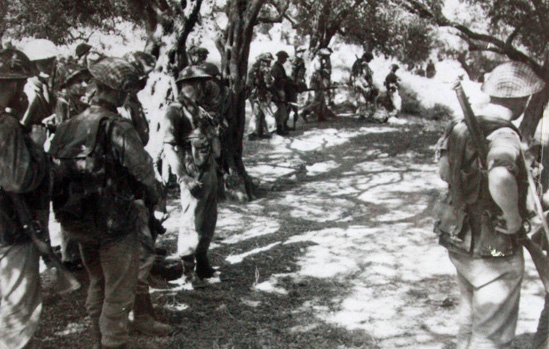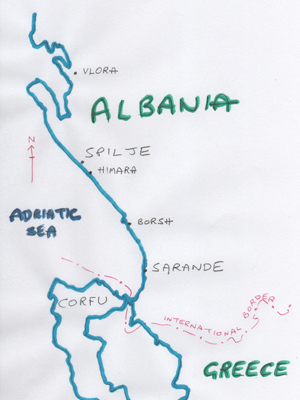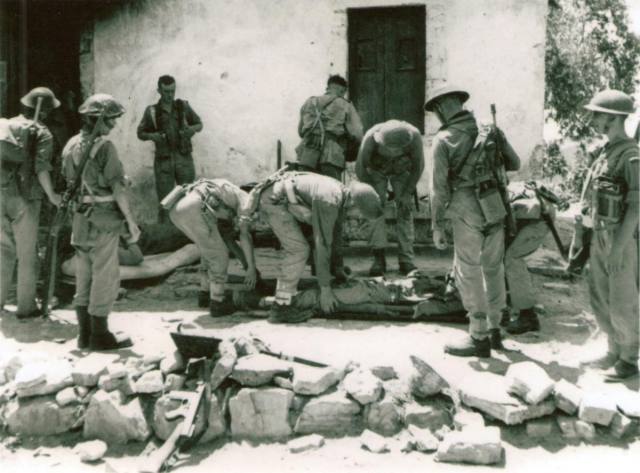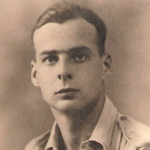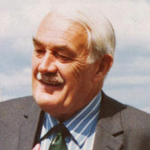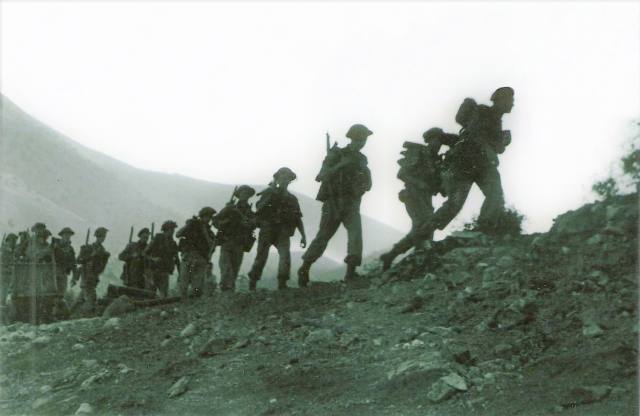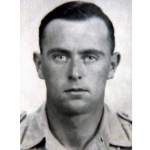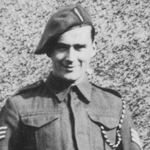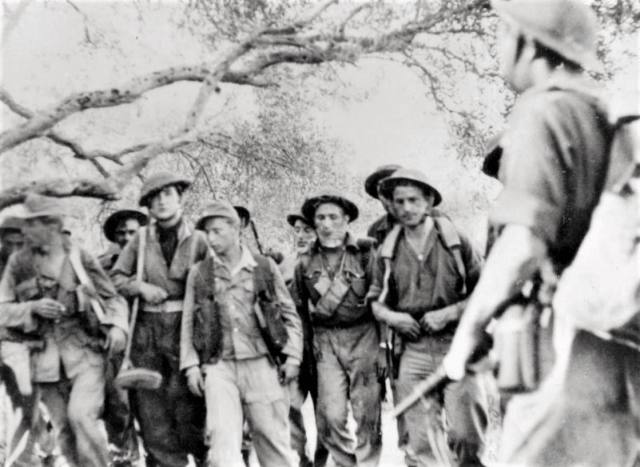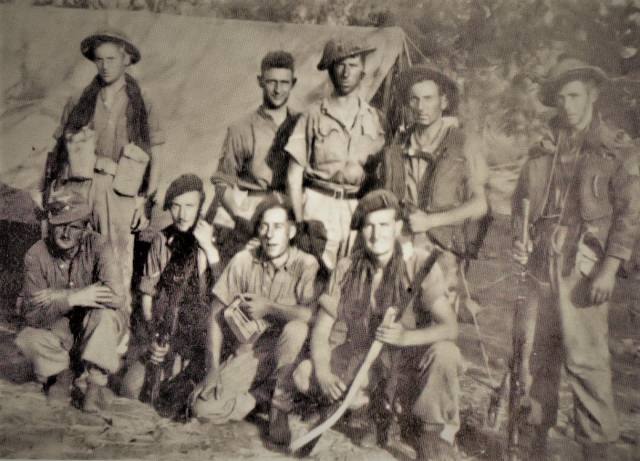Spilje Bay - Operation Healing 11
Primary tabs
Location
The above picture shows a troop of No 2 Commando forming up in an olive grove for an attack. The combined raiding force was part of Land Forces Adriatic. The sketch map was drawn by the author of this report.
Spilje Bay, Albania 28th – 29th July 1944
A report written by Harry Fecitt MBE, TD.
Allied interest in Albania
In mid-1944 as the Germans began to evacuate the Balkans it was decided to try and galvanise Partisans in the former Kingdom of Albania to attack Axis troops who were withdrawing from Greece. A British Special Operations Executive (SOE) mission had also been active in Albania but its results had not been spectacular as the commander and many of his staff were captured by enemy troops in March 1944. Albanian Partisans had been more than happy to fight Mussolini’s Italian troops who had invaded in 1939 but they were more ambivalent towards the Germans, often preferring to let sleeping dogs lie rather than to make attacks that resulted in savage German atrocities being perpetrated on local villages. Communists under Enver Hoxha dominated the Partisan groupings and their priority always was to be ready to seize power in the capital Tirana once the Germans had departed. One Allied Special Forces unit that showed keen interest in events in Albania was the Long Range Desert Group (LRDG) which was looking for a new theatre to deploy into now that all Axis troops had been captured in or expelled from North Africa. Since March 1944 The leader of the British SOE Mission to Enver Hoxha was Lieutenant Colonel Alan Palmer, Royal Regiment of Artillery, who made five parachute insertions into the country. He was closely involved with British Commando operations on the Albanian coast and his Mission was originally titled Force 266. The difficulties of successfully operating over the rugged and inhospitable Albanian terrain and of dealing with a population that often supplied the Germans with information can be assessed from Alan Palmer’s citation for the Distinguished Service Order that appears in Appendix 1 below. The value of this citation is that it describes events that led up to the decision to briefly deploy No. 2 Commando onto the Albanian coastline.Operation Healing II – the plan
HEALING II was designed to re-open the coastline in the neighbourhood of Himara so that supplies could be delivered to the Albanian Partisans in that area. Weapons, ammunition, equipment, clothing and boots were all needed because the Partisans were recruiting well from the civilian population but they were reliant on captured weapons and clothing. It was necessary for four German-garrisoned strongpoints north-east of Spilje to be destroyed before the coastline was secured, and five hours were allocated for this – in the event this was an insufficient amount of time. The Commandos were to be ashore for less than 24 hours and afterwards it was anticipated that the enemy would re-enter the area and be repulsed by the Partisans. The attacking force was just over 700 men strong and consisted of:- No.2 Commando – 250 all ranks (Lieutenant Colonel E. Fynn).
- 40 men of No.9 Commando acting as porters.
- A medical detachment from No.40 (Royal Marine) Commando.
- 180 men from the Raiding Support Regiment armed with 4 Italian 47mm anti-tank guns, 6 medium machine guns, six 3-inch mortars plus No.1 Mobile Protection Troop.
- ‘C’ Company 2nd Battalion The Highland Light Infantry (City of Glasgow Regiment).
- Inland, British officers from Force 266 ( redesignated as Force 399) and their Partisans, assisted by 20 LRDG soldiers, would organise prior reconnaissance and a link-up with the Commandos after the landing.
- The Royal Navy was to provide the necessary LCIs (Landing Craft Infantry) and two destroyers tasked with gunfire support.
- Weather permitting, air to ground fire support was arranged for the daylight hours particularly during the withdrawal.
The Operation
Colonel Fynn’s force sailed from Monopoli, south-east of Bari, Italy, on the night of 28th-29th July 1944. A successful unopposed night landing was made near Himara village four miles south of Spilje. A night march, serenaded loudly by village dogs, followed to the attack start line. The day-light attack commenced and the first problem occurred when the naval gunfire support officer fell over a cliff, damaging his radio set. Shells from the destroyers fell short amongst the Commandos, hitting men and radios, but the fire was not easily checked. Other radios could not work because their whip aerials could not clear the dense olive trees. The 3-inch mortar troop of the Raiding Support Regiment was heavily machine gunned as it moved forward, leading to it dropping its mortar equipment whilst cover from effective enemy fire was sought."Captain Webb was in command of a force of 2 Troops, which had to attack a series of strongly defended houses and machine gun posts. Throughout the action, Captain Webb’s cool, brilliant leadership, his complete unconcern at all times for his own safety, and his infectious aggressive spirit were an inspiration to all ranks. He led several assaults himself, continually urging and encouraging his men, and set a fine example, destroying the enemy himself wherever possible. During the heat of the attack he personally rallied his troops and led them on to the final assault. The success of this attack was very largely due to his dash and determination.
Later Captain Webb’s force was called to assist other Troops, who were held up, and again, despite the increasing numbers of snipers lying up in vineyards, his disregard for danger was outstanding. During a difficult dis-engagement and withdrawal, Captain Webb was a tower of strength, organising and giving personally every possible assistance to evacuate a large number of casualties back to the beaches. His bravery and unflagging energy undoubtedly saved the lives of several men. Captain Webb has shown consistent bravery and capacity for leadership in actions on the Dalmation Coast, notably on BRAC, where he was recommended.""Lance Corporal Anchor was in command of a bren gun. At dawn his troop led the assault against enemy positions, strongly fortified and tenaciously defended. During the early stages of the advance Lance Corporal Anchor, coming under vicious enemy machine gun fire, carried his bren gun forward across dangerously open ground. From now onwards, he not only succeeded in giving effective covering fire to the advancing troops and thereby the steady advance of the leading troops but continually engaged enemy strong points with deliberate and accurate fire, having complete disregard for his own personal safety.
In the final assault, Lance Corporal Anchor, observing several Germans immediately in front of him, displayed great initiative and courage, when, charging forward under intense fire he hurled a grenade in the midst of the enemy, who were making a last desperate attempt to hold the objective. This action contributed largely to their withdrawal from the position. By now a machine gun in the immediate vicinity was pouring bullets into the captured position. Lance Corporal Anchor located this machine gun and immediately engaged it through the window of his house forcing the enemy to stop firing and withdraw to another position. Throughout this action this Non-Commissioned Officer displayed not only courage and determination but great initiative at all times. His efforts contributed greatly to the success of the assault and were largely responsible for dislodging Germans determined to hold out at all costs.""This man showed great courage and determination throughout the action. In the early stages he was particularly conspicuous in the bayonet assaults. In the final stage during an attack on a fortified house, Dransfield’s section attacked but were held up by withering machine gun fire across very exposed ground. Dransfield, with complete disregard for his own safety, dashed through the fire, across open ground over barbed wire and through a suspected minefield to take up a position behind a wall on the enemy’s flank. He immediately brought accurate fire to bear on the enemy positions in the house. This attracted enemy fire away from his own section onto himself and enabled his section to re-group for a second attack. Under this hail of fire Dransfield was badly wounded in the leg. Despite this he continued to return the enemy fire, and when the second attack was launched he immediately joined in the assault, when he was again hit in the other leg. Although in great pain and bleeding profusely he crawled 20 yards and collapsed. This soldier’s offensive spirit and magnificent bravery were an outstanding example and inspiration to all."
Lance Bombardier John Willis Gelder, No. 2 Commando, whose citation for the Military Medal describes both the Commandos’ battle plan, the ground and the enemy defences. "This Non-Commissioned Officer showed outstanding courage, leadership and initiative. The attack in which he took part developed in three phases. In Phase 1 the attack was on a ridge studded with machine-gun posts. On the first burst of fire, the Section Sergeant and Corporal were hit, and Gelder immediately took control of the sub-section leading them with dash and no thought of personal danger. He saw that another section had eleven casualties from a machine-gun post, subsequently found to be manned by a German officer; he stalked this post despite the danger, and killed the officer with his Tommy gun. On Phase 2, Gelder collected remnants of the section and put in another attack on a machine-gun post, capturing the post and killing the occupants. On Phase 3 the objective was a strongly fortified house. The first attack was beaten off and Gelder was wounded. He refused to withdraw, and again went into the attack. He was hit in the face by a grenade, which exploded at his feet seriously wounding him. Despite this fact, he went on firing until his magazine was empty, encouraged the other men, who were now under mortar as well as machine-gun fire, and tried to carry a comrade out of action until finally collapsing. Gelder, who showed courage at Scaletta, Salerno and Hvar, acted as a Sergeant throughout this action, and was a great inspiration to his men. His gallantry in past actions earned him a recommendation at Salerno.""This Non-Commissioned Officer displayed untiring zeal, bravery and devotion to duty and was an example to all about him. Whilst under heavy shell fire he displayed the utmost coolness and disregarding his own safety entirely, he attended to the wounded and endeavoured to move them from the danger area. Later, during the attack he was constantly up with the assaulting troops in his capacity as medical orderly and he showed complete indifference to enemy fire whilst attending to wounded. He remained out under heavy fire dressing wounds and assisting in evacuating casualties. He went out repeatedly to bring in wounded men although he was continually sniped at and the ground was swept by enemy machine gun fire. He later remained out under heavy shell fire endeavouring to remove wounded to a place of safety. He was untiring in his work and at no time did he show the slightest regard for his own personal safety. His coolness and courage were great examples to those with him. During previous actions he has shown the same consistent devotion to duty."
Lance Bombardier Thomas Joseph Mulcahy, No. 2 Commando. This citation for the sixth Military Medal awarded for gallantry displayed at Spilje by No. 2 Commando personnel describes how LBdr. Mulchay stepped-up and took over a battlefield situation when his local commanders had been killed or wounded. "This Non-Commissioned Officer showed great courage and leadership throughout the action. In the early stages when his Section Sergeant was missing and his Corporal wounded, Mulcahy immediately took charge. He led his men into the assault showing complete disregard for his personal safety and carried the assault through to destroy two machine-gun posts and several weapon pits. Then when his section were pinned down, he carried out a reconnaissance under fire which enabled him to outflank these posts. In the final stages, his section was driven back in an attack on a strong point, but although wounded he rallied his men, and led a second attack in which he became more seriously wounded. Whilst lying on the ground, he encouraged his men and insisted on being the last to be evacuated. Throughout the action, he displayed great gallantry, determination and devotion to duty which, without question, materially contributed to the success of each assault. This Non-Commissioned Officer has repeatedly been outstanding in action and was recommended at Salerno."Withdrawal
By the time his five hours were up Colonel Fynn had accepted that his force was not strong enough to take all four reinforced enemy strongpoints above Spilje, principally because they had benefitted from an early warning of the British attack. Twenty British soldiers had been killed in action so far or were missing, and the unwounded remainder were exhausted. A move back to the beaches was ordered with priority being given to the evacuation of the 60 wounded men. The forward troops disengaged and fought a withdrawal action supported by smokescreens whilst stretcher bearers shuttled casualties down the steep slopes that had been taken from the enemy earlier in the day. Twenty five Germans had been captured and no doubt they assisted with casualty evacuation duties. Around 40 Germans had been killed and over 30 wounded and the survivors in their strongpoints were shaken by the ferocity of the British assault; many of them absconded during the next night and the remainder withdrew into woodland where the Partisans hunted them down and killed them. The aim of destroying the German garrison had been realised. Three German attempts to re-enter the area were repulsed by the Partisans. A fourth attempt succeeded but the troops involved were soon forced back by what was now a highly motivated Partisan force. The Royal Navy evacuated the HEALING II Troops back to Monopoli in Italy apart from three men of No. 2 Commando – Sergeant Douglas ‘Dink’ Webster, Gunner A. Pallet and Driver Roy John - who were left behind during the withdrawal. These three joined the Partisans for a time their evacuation was arranged. In Monopoli Colonel Fynn received a congratulatory and reassuring letter from the commander of Land Forces Adriatic, Brigadier G.M.O. Davey, who wrote: "I congratulate you on the excellent work done by you and the troops under your command in the HIMARA operation. Thanks to your careful planning and their very gallant fighting against a determined enemy and some objectionable Albanian quislings (some of whom were killed) the operation was a complete success. The object was the destruction of a German garrison. We know that it consisted of good German troops. You accounted for most of these, and the only remaining Germans were yesterday rounded up by the Partisans, who now control the coastal belt in that area. Your casualties were not light, but against them you must measure the set-back the enemy has suffered morally and materially in Albania. Then you will realise the extent of your achievement. Your No. 2 Commando has maintained and enhanced its already great reputation, and I should be grateful if you would convey my thanks to every member of it for his collective and individual part in a successful battle, the results of which are out of all proportion to the size of the Force engaged." Only a few weeks were to pass before No. 2 Commando was re-inserted onto the Albanian coastline for a new battle in support of Partisan operations.View a film broadcast about the raid here British Pathe News Film.
APPENDIX 1
Citation for the award of the Distinguished Service Order to Lieutenant Colonel Charles Alan Salier Palmer, Royal Regiment of Artillery. "Lieutenant Colonel Palmer was first dropped by parachute into ALBANIA on 10th October 1943. His task was to carry out a general reconnaissance of enemy occupied ALBANIA and then to proceed, with the organization necessary, to disrupt German communications in the South Eastern sector of the country. Whilst in command of a small operational mission in this area he formed, trained and led a force of local Partisans against the German Occupying troops. In March 1944, after the head of the British Mission in ALBANIA, Brigadier Davies, and most of his party had been captured, Lieutenant Colonel Palmer was placed in command of all British Missions working with the Partisan forces in ALBANIA. In this capacity he remained for most part with the General Staff of the Albanian National Liberation Army, advising, training and directing as far as was humanly possible the activities of this movement, to ensure that its operations coincided with the directives of the Supreme Allied Commander. Early in May 1944 Lieutenant Colonel Palmer carried out an offensive reconnaissance of Lake OHRID for a proposed seaplane landing. The following account of this reconnaissance is extracted from the diary of a field officer who accompanied Lieutenant Colonel Palmer. “To reach the lake within the time limit we marched for three days at great speed over mountainous country with only three breaks of two hours each for rest and food. The route lay through an area strongly held and patrolled by German and satellite troops. Lieutenant Colonel Palmer having completed the reconnaissance decided to blow the route on the western side of Lake OHRID between LIN and POGRADEC. His conduct during this action was remarkable. It was personally carried out by Lieutenant Colonel Palmer whilst German patrols were moving along the road which he was preparing for demolition.” A subsequent reliable report stated that the Germans attempted to rebuild the road with a force of 2,000 men, but failed and were obliged to conduct a long alternative route. In June 1944 the German 1st Mountain Division was sent from SERBIA to South ALBANIA for the express purpose of breaking up the Partisan organization in that area, which at the time was severely interfering with the lines of communication of Army Group F. This officer with all but one of the missions under his command was gradually forced to withdraw to a Partisan-held bridge-head on the coast near the village of BORSH. After ten days hard and close fighting it became apparent that the Partisans were not strong enough, or well enough equipped to prevent the elimination of this bridge-head. Lieutenant Colonel Palmer who had meanwhile assumed virtual command of all Partisan forces in the area decided to evacuate all but five of the British personnel under his command. This evacuation successfully completed, he, together with one officer and one W/T (radio) operator, in the face of heavy and concentrated machine-gun fire broke through the enemy lines in daylight. The Germans on discovering from local civilians that it was the senior British officer who had succeeded in penetrating their lines immediately gave chase. Only after fifteen days of constant pursuit, during which he underwent considerable physical hardship, and showed remarkable endurance, and in the face of constant betrayal by treacherous Albanians, did he succeed in re-establishing wireless contact with his HQ in Italy. As a direct result of the initiative and courage displayed in this action Lieutenant Colonel Palmer was able to regain contact with the Partisan GHQ and thus make possible the rallying and reformation of the remaining Partisan forces, who continued to resist the Germans and hampered their lines of communication. On four separate occasions when political relations with the FNC (Fronti Nacional Clirimatare – the Communist Partisan organisation) were critical to the extent of prejudicing all further military operations in ALBANIA, this officer has been summoned to ITALY to report to AOC Balkan Air Force. After each of these visits he has again been dropped by parachute into ALBANIA with fresh instructions. Due to his great patience, he has succeeded, to a very considerable extent, in imposing the wishes of the Supreme Allied Commander on the FNC. His courage and leadership shown on many occasions have been largely responsible for the very high esteem with which he is regarded by all Partisan commanders, including Colonel General ENVER HOXHA, and it was largely due to this esteem that Lieutenant Colonel Palmer has been able to impose the extent of control which was eventually achieved. This officer is still in ALBANIA as political adviser to the Commander of the British Military Mission. I have therefore the honour to submit that for his outstanding work, Lieutenant Colonel Palmer be awarded the DSO. Should this award be approved it is requested that no detail be made public or communicated to the Press." After the war Alan Palmer, a mobilised Territorial Army officer, re-joined his family business Huntley and Palmer. In 1963 he was appointed CBE ‘For services to the biscuit industry and to export’. He died in 1990.APPENDIX 2
The Fallen remembered with honour
Tirana Park Memorial Cemetery, Albania
Sergeant Jack Ernest Moores No. 2 Commando 'C' Coy., Highland Light Infantry (City of Glasgow Regt) 2nd Bn. (Land Forces Adriatic) [*]. Lieut. Alan Macdonald Sennett - Highland Light Infantry (City of Glasgow Regiment) 2nd Bn. Lance Serjeant Herbert Aveyard - Highland Light Infantry (City of Glasgow Regiment) 2nd Bn. Private Alexander Barr - Highland Light Infantry (City of Glasgow Regiment) 2nd Bn. Private John Casey - Highland Light Infantry (City of Glasgow Regiment) 2nd Bn. Private Norman Swanney - Highland Light Infantry (City of Glasgow Regiment) 2nd Bn. At least seven more burials in this cemetery are of unidentified personnel.Athens Memorial in Phaleron Cemetery, Greece
Lance Corporal Ernest Zeno Rosenstein, No. 2 Commando Gunner Nelson David Richardson - Royal Artillery attached to the Raiding Support Regiment.Bari Cemetery, Italy
Trooper Norman Bunn, No. 2 Commando. Bombardier Peter McDougall, No. 2 Commando Gunner David McMillan Miller, No 2 Commando Private Colin Peel - 'C' Company, Highland Light Infantry (City of Glasgow Regiment) 2nd Bn. (Land Forces Adriatic).The Cassino Memorial, Italy
Lance Corporal Henry Finn Hughes, No. 2 Commando; Lance Corporal John Brighty, No. 2 Commando. Gunner Peter Boon, No 2 CommandoAPPENDIX 3
Citation for the first award of the Military Cross to Lieutenant Michael Hinton Webb, 1/3rd Bn. Transvaal Scottish, Union Defence Force, South Africa. "During an enemy attack on our positions at BIR-EN-NAGHIA in CYRENAICA on the evening of 28 May 42, our forward outpost was compelled to withdraw owing to the fierceness of the attack. It was imperative for us to hold the outpost as it dominated our lines, and also the sectors held by the Battalions on our left and right. Lieutenant Webb was detailed to occupy the outpost with two sections. Under terrific shell and machine gun fire he reoccupied the post and successfully held it against several determined attacks during the period 28-29 May. At 0830 hours on 29 May he led an attack against the Italians who were endeavouring to dig in positions forward of his post. His personal dash and courage were an inspiration to his men and in no small way contributed to the success of the attack which resulted in the capture of over one hundred prisoners."SOURCES:
- Roderick Bailey. The Wildest Province. SOE in the Land of the Eagle. (Vintage Softback 2009).
- George A. Brown. Commando Gallantry Awards of World War II. (Private Publication 1991).
- General Sir William Jackson (compiler). History of the Second World War. The Mediterranean and Middle East. Volume VI. Victory in the Mediterranean. Part II – June to October 1944. (Naval & Military Press softback reprint of 1986 original publication.)
- James Ladd. Commandos and Rangers of World War II. (Book Club Associates London 1978).
- Charles Messenger. The Commandos 1940-1946. (William Kimber 1985).
- Hillary St. George Saunders. The Green Beret. (Michael Joseph Ltd 1949).
- William Seymour. British Special Forces. The Story of Britain’s Undercover Soldiers. (Grafton Books paperback 1986).
The Highland Light Infantry (City of Glasgow Regiment) 2nd Battalion was in Egypt on the outbreak of war. It fought in North Africa, Sicily, Italy, Syria and the Balkans, and served as peacekeepers in Greece in late 1944. [Source: National Army Museum].
Ask Questions / Add Information / Add Photos
Read some frequently asked questions here [FAQ's].

